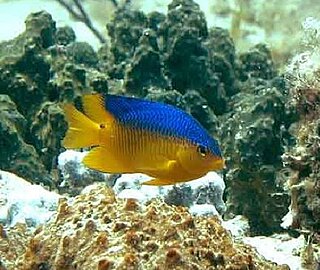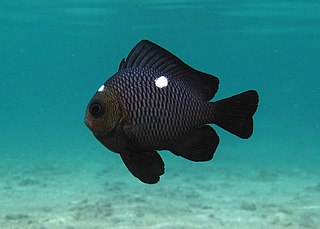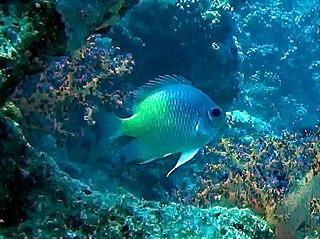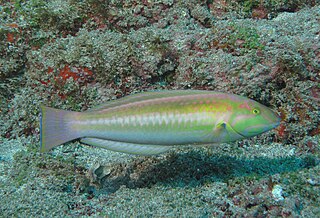Related Research Articles

Pomacentridae is a family of ray-finned fish, comprising the damselfishes and clownfishes. This family were formerly placed in the order Perciformes but are now regarded as being incertae sedis in the subseries Ovalentaria in the clade Percomorpha. They are primarily marine, while a few species inhabit freshwater and brackish environments. They are noted for their hardy constitutions and territoriality. Many are brightly colored, so they are popular in aquaria.

The wrasses are a family, Labridae, of marine fish, many of which are brightly colored. The family is large and diverse, with over 600 species in 81 genera, which are divided into 9 subgroups or tribes. They are typically small, most of them less than 20 cm (7.9 in) long, although the largest, the humphead wrasse, can measure up to 2.5 m (8.2 ft). They are efficient carnivores, feeding on a wide range of small invertebrates. Many smaller wrasses follow the feeding trails of larger fish, picking up invertebrates disturbed by their passing. Juveniles of some representatives of the genera Bodianus, Epibulus, Cirrhilabrus, Oxycheilinus, and Paracheilinus hide among the tentacles of the free-living mushroom corals and Heliofungia actiniformis.

Parrotfish are a group of fish species traditionally regarded as a family (Scaridae), but now often treated as a subfamily (Scarinae) or tribe (Scarini) of the wrasses (Labridae). With roughly 95 species, this group's largest species richness is in the Indo-Pacific. They are found in coral reefs, rocky coasts, and seagrass beds, and can play a significant role in bioerosion.

Thalassoma bifasciatum, the bluehead, bluehead wrasse or blue-headed wrasse, is a species of marine ray-finned fish, a wrasse from the family Labridae. It is native to the coral reefs of the tropical waters of the western Atlantic Ocean. Individuals are small and rarely live longer than two years. They form large schools over the reef and are important cleaner fish in the reefs they inhabit.

Dascyllus is a genus of fish in the family Pomacentridae. They are usually commensals with corals.

Dascyllus aruanus, known commonly as the whitetail dascyllus or humbug damselfish among other vernacular names, is a species of marine fish in the family Pomacentridae.

The threespot dascyllus, also known as the domino damsel or simply domino, is a species of damselfish from the family Pomacentridae. It is native to the Indo-Pacific from the Red Sea and East Africa, to the Pitcairn Islands, southern Japan, and Australia, and can also be found in some parts of the Philippines. Its grey to black body has two lateral white spots and one between the eyes like domino hence the name; the threespot dascyllus grows up to 13 cm in length. Coloration is somewhat variable; the spot on the forehead may be absent and the lateral spots very much reduced. It feeds on algae, copepods and other planktonic crustaceans.

The nosestripe clownfish or nosestripe anemonefish, skunk clownfish, Amphiprion akallopisos, is an anemonefish that lives in association with sea anemones. A. akallopisos is found in the Indian Ocean. It resides in shallow inshore reefs as deep as 15 m with a moderate to strong current. The skunk clownfish can also be kept in captivity by aquarists.

Stichodactyla mertensii, commonly known as Mertens' carpet sea anemone, is a species of sea anemones in the family Stichodactylidae. It is regarded as the largest sea anemone with a diameter of over 1 m (3.3 ft), the next largest being Heteractis magnifica, which has longer tentacles. This species has an oral disc that can be described as more ovoid than circular that contours to the surrounding substrate and is attached to the substrate by adhesive verrucae, which are wart-like projections. Its blunt or pointed tentacles are uniformly shaped, and are only about 1–2 centimetres (0.39–0.79 in) long. It contains obligate symbiotic zooxanthellae, and is a host to around half the species of anemonefish and one damselfish, Dascyllus trimaculatus.

Dascyllus melanurus, known commonly as the four stripe damselfish, blacktail dascyllus, humbug damselfish, blacktail damselfish, and blacktail humbug, is a species of fish in the family Pomacentridae. It is native to the western Pacific Ocean. It is sometimes kept as an aquarium pet.

Dascyllus reticulatus, known commonly as the reticulate dascyllus or two-stripe damselfish among other vernacular names, is a species of marine fish in the family Pomacentridae.

Dascyllus marginatus is a damselfish endemic to the Western Indian Ocean. It is a site attached fish that lives in corals, usually Stylophora pistillata and species of Acropora. In these corals it hides at a moment of danger and sleeps at night. Dascyllus marginatus lives in groups of 2-25 individuals. It feeds on zooplankton that drifts with the current, and grows to a size of 6 cm in length.

Dascyllus flavicaudus, common name yellowtail dascyllus, is a Damselfish belonging to the family Pomacentridae.

Jansen's wrasse is a species of ray-finned fish, a wrasse from the family Labridae which is native to the Indian Ocean and Pacific Ocean. In the south-western Pacific Ocean it is replaced by sibling species black-barred wrasse. It can be found in the aquarium trade.
Alice Alldredge is an American oceanographer and marine biologist who studies marine snow, carbon cycling, microbes and plankton in the ecology of the ocean. She has conducted research in the open sea, at her laboratory at the University of California, Santa Barbara as well as in collaboration with the Long Term Ecological Research Network (LTER) at the Mo'orea Coral Reef Long Term Ecological Research Site in Mo'orea, French Polynesia. According to the annual ISI Web of Knowledge list published by Thomson Reuters, she has been one of the most cited scientific researchers since 2003.

Amblyglyphidodon flavilatus, known as yellow damselfish, yellowfin damselfish, yellow flank damselfish, yellow side damselfish, and yellow-sided Damselfish, is part Pomacentridae, which is a family of ray-finned fish including damselfish and clownfish. This family represents the greatest diversity and abundance of fish species inhabiting coral reefs. They were first described in 1980 by Allen and Randall.

Sebastes diaconus, the deacon rockfish, is a species of marine ray-finned fish belonging to the subfamily Sebastinae, the rockfishes, part of the family Scorpaenidae. It is found in the eastern Pacific Ocean.

Halichoeres rubrovirens, the red-green wrasse, is a species of wrasse native to the western Atlantic Ocean, being found in the islands of Trindade and Martim Vaz in southeastern Brazil. It's found on rocky reefs at depths of 5-30m, and juveniles seem to mimic and usually school together with Thalassoma noronhanum which they resemble in color. They are not genetically close to any other species of Halichoeres in the Atlantic, and are likely a relict species.

Cirrhilabrus finifenmaa, also known by its common name rose-veiled fairy wrasse, is a rainbow-colored wrasse that is native to the reefs of the Maldives.
Chromis verater, commonly known as threespot chromis, is a species of damselfish endemic to Hawaii. The species is planktivorous.
References
- ↑ "Giacomo Bernardi". Archived from the original on 2011-07-16. Retrieved 2010-03-29.
- ↑ "EEB Faculty - Giacomo Bernardi". Archived from the original on 2010-06-08. Retrieved 2010-03-29.
- ↑ "Giacomo Bernardi | Gump Station". Archived from the original on 2010-06-20. Retrieved 2010-03-29.